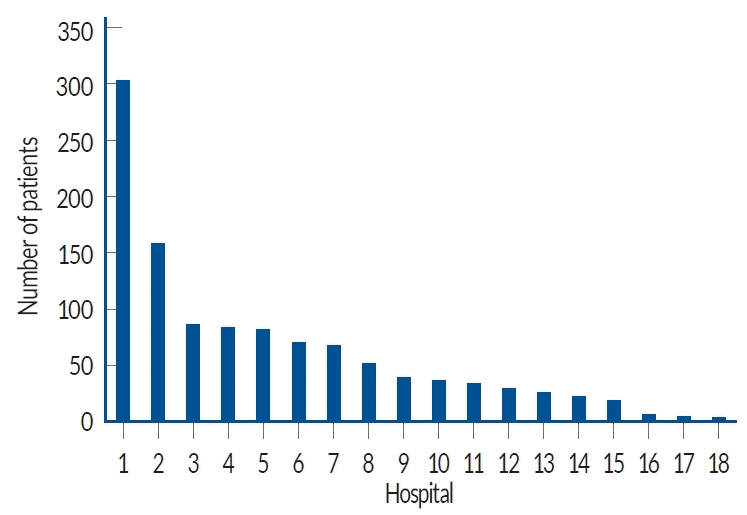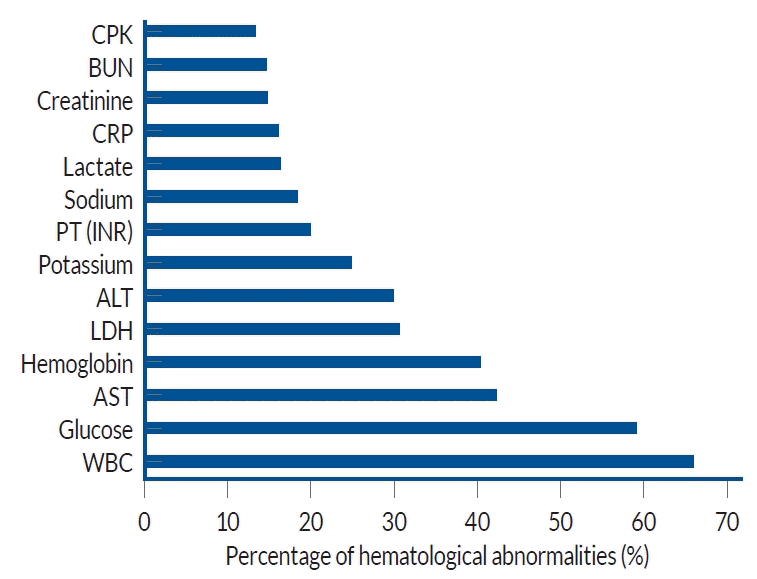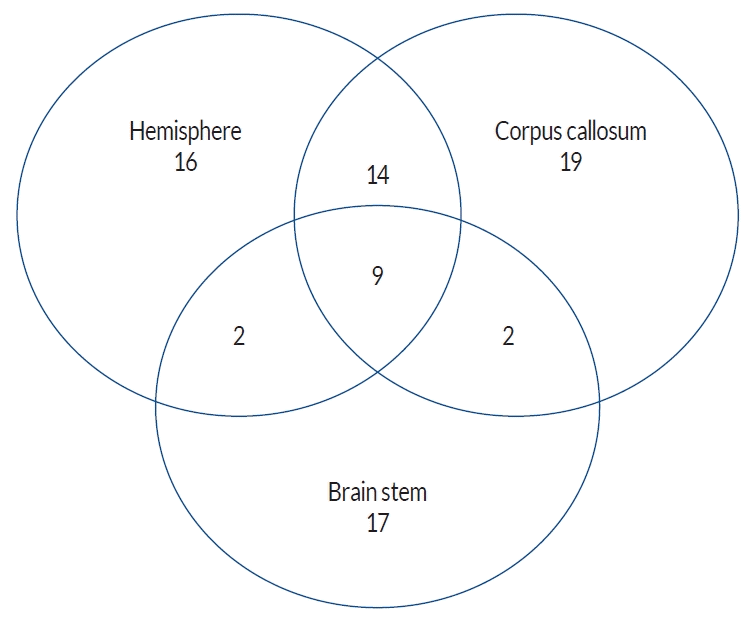INTRODUCTION
Trauma data are used to evaluate and prevent trauma-related injuries. They also play a crucial role in clinical studies, helping to manage the quality of trauma care and establish effective treatment plans [
8,
10-
12]. Many countries, including the United States, Japan, and Germany, have established databases and registered patients to manage trauma care efficiently [
8,
10,
11]. In 2006, the Korean Neurotraumatology Society (KNTS) established the 1st Korean Neurotrauma Data Bank Committee (KNTDBC) and developed the Korean Neurotrauma Data Bank System (KNTDBS). Full-scale registration of traumatic brain injury (TBI) patient data began in September 2010 [
8,
12]. Since then, the KNTS has carried out two trauma-related data registration projects and has continued through to the 5th KNTDBC. Data from the second project, which began in 2017, were registered into seven major categories : patient registration, neuroimaging, neuromonitoring, hypothermia, surgical treatment, medical treatment, and patient evaluation. The Abbreviated incentive scale (AIS), Injury severity score (ISS), and Trauma and incentive severity score (TRISS) were used to collect data on multiple extra-cranial injuries, and the computed tomography (CT) Rotterdam score was introduced to the field of neuroimaging [
6,
9]. Specific data on decompressive surgery were registered in the field of surgical treatment, and the followup observation period was designed to collect data for up to 3 and 6 months [
13]. This study aimed to introduce the KNTDBS of the KNTS and report the results of the second project.
Go to :

MATERIALS AND METHODS
This retrospective study was approved by the Clinical Research Ethics Review Committee of Wonkwang University Hospital (WKUH 202408017).
The KNTS registered data from January 2018 to June 2021 through the KNTDBS. A total of 14 data committee members consisting of neurosurgeons from each university hospital nationwide (the 5th KNTDBC) were part of this project. Although 28 university hospitals expressed their intention to participate in the second project before data collection, only 18 of them registered (registration participation rate, 64.3%). To improve data quality and uniformity, detailed data registration guidelines were established and provided to the person in charge of registration at each hospital. The inclusion criteria were 1) patients who visited the hospital due to TBI, 2) severe TBI patients with a Glasgow coma scale (GCS) score of 8 or below, and 3) adult patients aged 19 years or older. Exclusion criteria were 1) patients under 18 years of age, 2) patients with a GCS score of 9 or higher, and 3) patients with a history of previous craniotomy or craniectomy. A total of 1122 TBI patients were registered from 18 hospitals (
Fig. 1), of which 76 had poor data owing to duplicate registrations or incomplete basic information, and 13 had no data on diagnoses. Therefore, data of 89 patients were excluded; finally, a total of data of 1109 patients were included. Hematological findings were checked only for abnormalities. When multiple diagnoses were made, only one of the most representative diagnoses was considered. To compare the results of the first project with the data from this second project, data were extracted from the first project. The inclusion criteria for the first project, conducted from 2010 to 2014, included all admitted head trauma patients with a GCS score above 3. The exclusion criteria were severe extracranial injury, cerebral concussion, and chronic subdural hematoma [
12]. Out of the total 2617 registered cases, 2215 patients with a GCS score of 9 or higher were excluded, along with 22 patients under the age of 19. This resulted in 380 patients, whose data were then compared with the results of the second project using comparable common parameters (
Fig. 2). The AIS scores, which require significant time and effort to input, were only registered for patients who visited the regional trauma center. This is because it is the responsibility of the trauma specialist coordinator at the regional trauma center to register the AIS. Of the 18 participating hospitals, seven were regional trauma centers, with a total of 697 patients. Among these, 12 patients were excluded due to incomplete registration data, leaving a total of 685 AIS records included in this study. The amount of bleeding in traumatic intracerebral hemorrhage (T-ICH) and acute epidural hematoma (A-EDH) was calculated and entered using the formula ABC/2 on CT images. Hematoma thickness on CT was recorded only in cases of acute subdural hematoma (A-SDH). The CT scoring system used was the Rotterdam CT classification [
6,
9]. The size of the craniotomy was measured as follows. 1) It was measured at the level where the third ventricle first became visible on the CT scan. 2) The measurement was taken by connecting the inner tables of the skull. 3) If a coronal CT image was unavailable, the measurement was performed using an anteroposterior skull radiograph.
 | Fig. 1.Number of patients registered at each university hospital. 
|
 | Fig. 2.Comparison of the first and second project of the Korean Neurotraumatology Society. TBI : traumatic brain injury, GCS : Glasgow coma scale, C-SDH : chronic subdural hematoma. 
|
Statistical analyses were performed using SPSS version 23.0 (IBM SPSS Statistics for Windows, version 23.0; IBM Corp., Armonk, NY, USA). Continuous variables were analyzed using the independent t-test, while categorical variables were assessed with Pearson’s chi-square test. Differences were considered statistically significant at p<0.05.
Go to :

DISCUSSION
The KNTS formed the first KNTDBC in 2006 and established an online registration system with multi-institutional access and a web-based KNTDBS, laying the foundation for the epidemiological investigation of severe TBI patients and evaluation of treatment outcomes [
8]. The second KNTDBC, established in 2010, conducted the first project including all TBI patients with a GCS score of 3 or higher and excluding those with severe extracranial injury, cerebral concussion, and chronic subdural hematoma. Between September 2010 and March 2014, 2698 TBI patients were enrolled from 20 hospitals [
4,
12]. The third KNTDBC, established in 2015, analyzed the data collected during the first project to evaluate its usefulness and identify issues. It was responsible for writing of the paper [
4,
12]. In 2017, the 4th KNTDBC was formed to prepare for a second project on severe TBI. The first project had no professional personnel or facilities to operate the KNTDBS and faced numerous limitations owing to lack of financial support. There was a large difference in the registration rates among the institutions, and there were many missing data points [
12]. Therefore, the 4th KNTDBC, which planned the second project, aimed to improve the Korean treatment guidelines for severe TBI patients by accurately registering standardized data to improve data quality. The 5th KNTDBC, established in 2021, collected data on severe TBI from multiple institutions. To improve the quality of data collected from multiple institutions, it is important to first standardize the data and register the patient’s exact condition [
8,
10,
11]. In this study, 1122 patients were enrolled from 18 hospitals; however, there was a large gap in the number of enrolled patients between hospitals (
Fig. 1). Although this was identified as a limitation in the first project, it was not addressed in the second project. Because the registration rate is bound to differ depending on the circumstances and capabilities of each hospital, the only approach to solve this issue is to hire a registration committee member who specializes in data registration and is in charge of registration.
The characteristics of TBI patients in this study were not significantly different from those in previous studies, including the 1st project of KNTS. In most studies, the rate of TBI in men was 2–3 times higher than that in women [
4,
12]. However, there were some significant differences compared to the first project. The average age for adult severe TBI increased from 54.5 to 58.3 years for men and from 60.7 to 63.6 years for women. There were also notable differences in age distribution, particularly a significant decrease in patients in their 40s and a significant increase in those in their 60s and 80s. This may be attributed to the rise in average life expectancy. TBI is particularly common among individuals aged 50–70 years, a period that marks the transition from middle age to old age. Therefore, education and attention are needed for this age group. When data from severe TBI patients were collected, the diagnosis revealed the highest proportion of T-SDH [
4,
12]. Similar to previous studies, falls or slips accounted for 45.3%, and traffic accidents accounted for 38%, indicating that falls continue to be the primary cause of TBI [
4,
12]. Compared to the cause of TBI in the first project, traffic accidents decreased and falls and slip down statistically increased in the second project. Since the focus was on severe TBI in adults, A-SDH was the most common diagnosis in both groups, and there was no significant difference in the rate of surgical treatment and mortality. This suggests that the survival rate has not yet been significantly improved in severe TBI. At the time of ER arrival, the GCS showed a large number of severe patients with scores of 3 and 4, which was associated with the highest portion of patients having bilateral pupils with unrecordable responses, accounting for 561 cases (50.6%). TBI patients frequently exhibit abnormal pupil responses. In severe TBI, acute pupil dilatation is a neurological emergency, and non-reactive pupils are linked to a poor prognosis [
5].
In this study, to score patients with multiple injuries, the body was divided into six regions, and the AIS was used to assign a score of 1 to 6 according to the degree of injury for each region. An interesting observation is that, despite serious and critical head injuries, injury to other parts tended to be mild or less severe overall. This suggests that severe head injuries are not often accompanied by extracranial injuries, indicating that the outcomes of severe TBI of adult are most affected by head injuries. Additionally, severe TBI often presents with abnormal hematological parameters. These abnormal parameters are associated with poor mortality outcomes after TBI [
3]. When planning the second project, the original design was to register all abnormal hematological parameters, including specific abnormal values. However, the process of registering a large number of parameters was time-consuming, leading to increased fatigue among registrants and the potential for lower data registration rates. Consequently, it was modified to register only the presence or absence of abnormal findings. As a result, it became difficult to obtain useful data for evaluating patient prognosis through hematological findings.
The Rotterdam CT score is a classification system designed to improve the prognostic assessment of patients with moderate to severe TBIs [
6,
9]. In adults, the mortality rate increases with higher scores over a 6-month period [
6]. In this study, Rotterdam CT scores of 5 and 6 points were mostly A-SDH, suggesting that A-SDH is highly associated with the morbidity of severe TBI. Surgical treatment was performed in 36.2% of all TBIs cases, compared to that in a previous study (24.6%). However, it should be noted that past studies also included mild and moderate TBI cases [
12]. In this study, all cases of DAI were diagnosed using magnetic resonance imaging (MRI). According to the MRI-based grading of DAI (reference literature), the distributions of DAI were 16 patients (20.3%) for grade 1, 33 patients (41.8%) for grade 2, and 30 patients (38.0%) for grade 3. As this study was conducted on patients with severe TBI, the ratio of grades 2 and 3 was higher than that in previous studies [
12]. The amount of intraoperative transfusion had a very large standard deviation for all diagnoses, suggesting that unexpected situations frequently occur during TBI surgery.
Although the use of AEDs to prevent post-traumatic epilepsy is standard practice, there remains significant controversy surrounding their prophylactic use [
2]. Phenytoin and valproate have traditionally been used intravenously as prophylactic AEDs for early onset seizures; among them, phenytoin has been mainly recommended [
1]. However, since the 1990s, the use of second- and third-generation AEDs has increased rapidly, and the use of lamotrigine and levetiracetam has continued to increase [
1]. In this study, most university hospitals used levetiracetam and valproate (
Table 6). All seizures occurred in patients who underwent surgical treatment after TBI, and none occurred in patients with DAI. In Korea, neuromonitoring, hypothermia, and coma therapy are not actively performed. Further research is required to determine the effectiveness of these treatments on outcomes in TBI patients. Although ventricular dilatation is frequently found, shunt surgeries are relatively rare. The reported incidence of symptomatic hydrocephalus after TBI varies widely, ranging from 0.7% to 29% [
7]. Of the 740 survivors in our study, 3.9% underwent shunt surgery.
One of the most challenging issues since the implementation of the first project has been the clear establishment of criteria and definitions for multiple or combined injuries within the diagnosis categories. In reality, many patients present with various combinations of TBI, which could have been a major factor in reducing the reliability and consistency of the data (e.g., A-SDH with A-EDH, A-SDH with T-ICH, A-SDH with A-EDH and DAI, etc.). However, including combined traumatic lesions would significantly increase the number of parameters to be registered, and establishing criteria for each would have been a highly challenging task. In the end, we were unable to find an adequate solution, so it was decided to register only the most representative diagnosis when multiple diagnoses were present. However, clearer classification of combined injuries is one of the most critical aspects of trauma databank registration and management, and it is an issue that must be addressed in the 3rd project of the 5th KNTDBC. Additionally, to ensure consistent and standardized data registration, it is essential to secure qualified trauma-related data entry specialists. A systematic protocol for efficient system management and ethical review must also be established.
Go to :






 PDF
PDF Citation
Citation Print
Print







 XML Download
XML Download